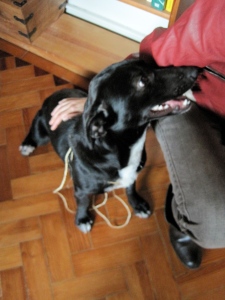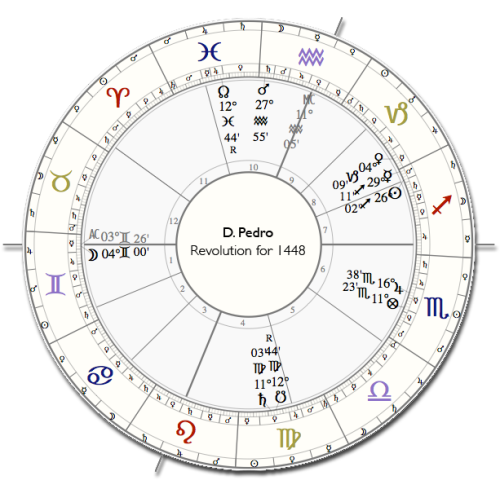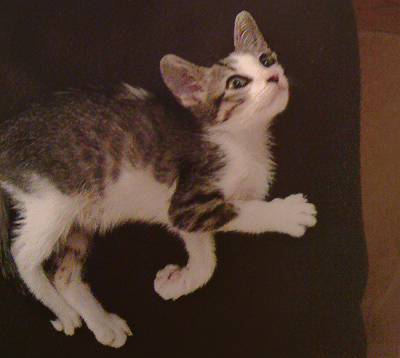
Old habits die hard – this is certainly true for astrology students who try to ‘go Traditional’ after several years of contemporary practice. As an increasing number of students reach intellectual maturity, they choose to study the Tradition, in order to expand and deepen their astrological knowledge. But this study, although simple at first glance, is in reality quite difficult. It requires a complete mind set change, discarding the old habits and allowing new ways to ‘think astrology’. It is a major change, for it implies modifying the very core of astrological perception.
This change has proven to be as difficult and challenging as, say, learning to write with the non-dominant hand – no simple thing, as can be easily confirmed by anyone who tries it. The difficulty resides in the long-established habits of thinking (the more physiologically-inclined would refer to the neurological pathways of the brain) which prevent, or at the very least make it very hard, to have new thoughts regarding ‘old’ topics. In other words: it is difficult to learn a new astrological approach (in this case the Traditional one) because of old, deeply embedded astrological habits, which in most cases were learned and practised for years.
In this article we will present some suggestions on how to bypass these old habits, in order to establish a solid foundation to the leaning and practising of the Tradition.
Pride and prejudice
First of all, let us talk about the most difficult factor of them all: pure and simple pride.
Those who studied contemporary astrology enthusiastically and whole-heartedly for years, no doubt take some pride in their technical knowledge and delineation skills. It is therefore understandable that they respond with raised eyebrows to any suggestion that they might be partially wrong. How can they be wrong? Well, it happens. Everybody is wrong on occasion, but only a few will openly admit it. It surely happened to the contemporary renowned traditional astrologers as they, just as everybody else, started by learning contemporary astrology, and at a certain point they had to admit they were wrong, in order to expand their astrological knowledge. So, if they did, why don’t we?
Those who surpass this first obstacle soon find themselves in new and exciting territory, full of possibilities. Some see it as an alternative to the more contemporary approaches of astrology – and here we find our first prejudice. Traditional astrology is not just another alternative; it is not another way to look at it, or a new trend born out of the dusty mind of some eccentric traditionalist, and soon to be forgotten. Traditional astrology is ‘the real thing’. It is astrology as it has been practised interruptedly throughout the centuries, without major reformulations or additions.
Traditional astrology sets the rules for reliable delineation and it offers the possibility to accurately predict future events. ‘To predict’ – here is another prejudice related to Traditional astrology, the recurrent accusations of determinism. It is out of the scope of this article to discuss this matter in depth, so we will only state that astrology (whether Traditional or Contemporary) is not fatalistic, although some astrologers (again, Traditional or Contemporary) are. This concept emerged around the beginning of the 20th century, and it has ever since been used as an excuse to dismiss the Tradition, it came forth from the ignorance of some astrologers, who simply could not understand the Traditional rules (or go to the trouble of study them) and so decided they had to be reformed, to adjust to their own and simplified view of the Universe.
Yes, it is possible to predict with Traditional astrology, as long as the Traditional rules are correctly understood and applied. And by the way, the long-term dispute between fate and free will is, in fact, pointless as they both have their place in Traditional astrology.
Less is more
The first practical step towards the Tradition is to ‘clean’ the chart, to make it work better. Simple and clear charts work better, cluttered charts confuse the mind. So, what should we take away? Well, modern astrology, of course, and all that pertains to it!
– Planets
Let us start by taking of the modern planets – all three of them, Uranus, Neptune and dwarf Pluto. And since we are at it, let us also remove the asteroids, planetoids, midpoints, etc. Every celestial body that cannot be seen by the naked eye has to go. For some astrologers this is a bold step and a frightening one too. Facing an almost empty chart is almost like looking into the abyss, but as Nietzsche would say “it also looks back at you” (1), and in this case it reveals the very essence of the chart. By clearing the chart, we allow the mind to quiet and to focus; only then can we perceive the perfect balance of the spheres, without the ‘white noise’ of all the extra planetary bodies. From the apparent emptiness surfaces a complete and deep delineation.
– Aspects
Since we are talking of ‘empty’ charts, we might as well know that there is yet another level of emptiness to achieve that is, the removal of the aspect lines in the centre of the chart. This avoids distractions, and keeps the students from jumping into the aspects right away, even before weighing the planets and determining significators. Although removed from the chart, the aspects will not be lost; they can be listed on the side, or simply calculated when needed during the delineation (and yes, this is perfectly possible, as any of our 1st degree students would confirm). Another important change: only the conjunction and the major aspects – opposition, trine, square and sextile – are considered in the Traditional system; all the minor aspects disappear (2).
– Orbs
Since we are at it, we might as well reset the orbs of the aspects according to the Traditional rules. That means that instead of orbs by aspect, we will have orbs by planet – a totally new concept. In practice, we gain some aspects, and we lose some too; the results are sometimes surprising.
So we now have an empty, almost ‘zen’ chart, with ‘only’ the seven classical planets, and ‘only’ the classical aspects, with no aspects lines in the centre, and with a completely different concept of orbs.
After all these changes, are we ready to go traditional?
Not quite yet. There are a few more technical adjustments to do.
– House System
The other main technical point is the choice of a house system. We will not go into much detail here, as this topic has been widely discussed among the main experts of this field. Some astrologers choose a house system appropriate to the period he/she intends to study, while others prefer to apply different systems for different purposes (for instance: one for natal, another for horary), and others look for a ‘universal’ system, suitable for all purposes and periods.
In any case, astrologers should understand, at least in general terms, the mathematical and philosophical principles of the system of their choice. And we don’t mean just to know that a give system divides time, or another divides space, we mean the mathematics! Again in any case, they should not choose randomly, nor use a system just because it is the default of the computer, or because everyone else uses it.
So finally, we have attained the technical basis for a Traditional chart – a simple, clean and functional chart. But there is something still missing. The Traditional chart is just the starting point, not the goal in itself. We still have to learn to interpret according to the Traditional rules, and for that we need to shift from a Contemporary mind set to a Traditional one – and that is the real task.
No artificial additives, please
Here is the really difficult part: even when we understand the technicalities and have the ability to ‘read’ the chart in the appropriate language, we can still feel the need to add something more to the reading. For some astrologers this means adding some ‘extras’, like tarot, chakras, crystal-therapy or reiki (or everything together). While all these topics can be valid ways to express one’s spirituality, they can also be a distraction to our main goal: astrology, and the ability to deal with it efficiently. And for some astrologers this habit of adding extras is so embedded they cannot read a chart without them.
Among the most common additives to astrology today we find mythology, psychology (in some cases, psycho-babble) and all sorts of therapeutic approaches. Although it is appealing to combine astrology to all these things, the fact is that the majority of practitioners replace astrological knowledge and technique with them. Therefore, their replacements are used as ‘patches’ to compensate for technical inconsistencies and to cover for pure and simple ignorance of the astrological system.
To put it crudely: if astrology doesn’t work without ‘extras’, it is because the astrologer didn’t learn it properly, and so it is the astrologer who cannot ‘work’ properly. This should not be taken personally, for it is not that big a deal. The great majority of today’s astrologers have learned astrology the ‘bad’ way (that is incorrectly, incompletely and mixed with other subjects), simply because that was the only astrology available at the time. Only afterwards were some of them able to un-learn the bad habits and begin to move towards a better astrology – as so many students are trying to do now.
When we understand the main astrological techniques and achieve some proficiency, we perceive astrology as an autonomous and proficient knowledge, able to function by itself, so no additives are necessary to make it work.
Learn it properly – from the start!
If we study the Traditional system thoroughly, with dedication and commitment, we soon find out that it works. Astrology describes reality as it is, and if we learn to read a chart (whether natal, horary or other) according to the Traditional rules, we can attain that ability. We fail eventually, of course, but it will be by our misunderstanding of the system, not by astrology’s fault.
Unfortunately, some prefer to attribute their own mistakes to any other cause but to themselves. Therefore, some say the ‘malfunction of astrology’ results from the loss of ‘ancient knowledge’; although part of this is possible, we have nonetheless a significant amount of knowledge retrieved from ancient sources, more than enough to provide complete and accurate readings. Others prefer to attribute their astrological faux pas to the gap between ‘old’ astrology and ‘human evolution’, arguing that humanity has reached a state where the ‘old’ techniques no longer apply. To those it must be pointed out that astrological knowledge is perennial and therefore appropriate for all stages of evolution; cultural or technological change should not be confused with the transcendence of the human condition; all things considered, in essence we are really not that different from our ancestors. In fact, the so-called malfunction of astrology is due to a simple fact: students don’t learn it properly. They should allow themselves enough time to learn, to practice, to fail, to understand the mistakes and to correct them.
Our suggestion is to keep astrology as a separate field, at least during the learning process. This will give it room to develop as an independent field of knowledge and allow the student to apprehend its specificity. If we don’t do it, we will never be able to learn astrology properly, by itself, and we will go on insisting that it does not work.
No shortcuts
This process of learning astrology in its purest state – that is, according to the Traditional rules and without mixture – requires two things: patience and trust. It takes a while to learn the basic concepts, and a while longer when we have to un-learn the contemporary theories and then re-learn everything according to the rules. It takes a bit more to re-gain proficiency in interpretation and prediction, and much more to achieve a deep, intuitive (often a misused word) understanding of the astrological principles. Only deep study and commitment can bring depth and solidity to astrological knowledge. But patience is only a part of the requirements to get rid of old habits and re-learn astrology; trust is the other, and no lesser, part.
As we all know, trust does not come easy; trust grows in us – slowly and tentatively. This is so for any situation, and it is particularly true for astrology students, as they are trying to make sense of a singular and somewhat marginal knowledge, very different form the present-day Cartesian-based thought. In astrology, trust must come from study, deep thought and experience – and all this requires a long period of development, which brings us back to the patience topic. So this is the knot we have to untie: on one hand patient study which requires an a-priori trust in the astrological system, on the other, the ability to trust the system even before it has proved itself reliable. Unlike the proverbial Gordian knot (3), this one cannot be impatiently severed by a stroke; the only way to do it is the patient way. There are no shortcuts in astrology.
Here and now
Still talking about ‘extras’, it is worth mentioning that some astrologers feel the need to refer to the native’s past lives while reading the chart. This is a rather common practice, and in fact it is regarded as a ‘must’ by some. Nowadays it is almost compulsory for the beginners to bring the subject into their readings. This distracts the native from the most important moment of his/her life: the present. In short: while reading a chart, keep the past lives in the past and the evolution in the future; focus on the present. Describe the native’s here and now, enhancing his/her skills and possibilities, goals and challenges. A good, solid reading, delivered in a clear and realistic manner, is much more impressive – and more useful, in both the material and the spiritual planes – than any speculative interpretation of past or future lives.
Thou shall not preach
Personal beliefs are not part of astrology. Some astrologers are deeply religious, others are not. They both can be good astrologers, or they can be bad ones – it all depends on their astrological skills, that is, their capacity to interpret an astrological chart. Personal beliefs do not necessarily enhance the astrologer’s abilities; in fact they can even diminish them, as they hinder the astrologer’s neutrality and clarity of mind.
So, astrologers should suspend their pre-judgements when it comes to this matter. Spirituality is – we must keep in mind – a very personal and private matter, totally independent of the astrological practice. Opinions and experiences regarding spiritual matters can of course be addressed on many occasions, as they constitute an important part of life for many people; they should not however be mingled with the astrological reading, nor should they be imposed in any way (directly or indirectly) through astrological means. Astrology is a language, and it is meant to be clear and reliable, it should not be a means to impose on others our own personal views.
Becoming an astrologer
So here it is, a general overview of the ‘old habits’ that any student must bypass in the transitions between Contemporary and Traditional astrology. To get over these habits is the task of all serious astrologers, as they stand in the way of astrological maturity.
Paraphrasing Simone de Beauvoir, we could state that one is not born an astrologer, but becomes one (4) – and we may add that the quality of what the astrologer we will become depends largely on our effort and commitment to overcome our flawed education, eradicate old habits and finally reconnect to the source of astrological knowledge – the Tradition.
Helena Avelar
Endnotes:
(1) From his book, Beyond Good and Evil; the exact quotation is “… if you gaze long enough into an abyss, the abyss will gaze back into you”.
(2) Except in primary directions, as exemplified by William Lilly in his delineation of the Merchant’s chart, Lilly, William, Christian Astrology, pg. 765.
(3) Gordian knot: a metaphor for a intricate problem where the only solution would be a sudden stroke; the name comes from a legend related to Alexander the Great.
(4) The correct quotation form Simone the Beauvoir (1908-1986), is “one is not born a woman, one becomes one”, or alternatively “one is not born, but rather becomes, a woman” (alluding to the pressure forced upon women to act and behave only in the ways approved by the patriarchal society).






















